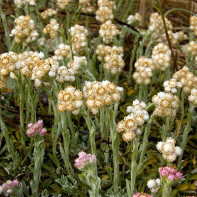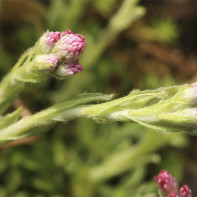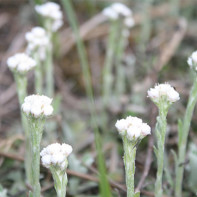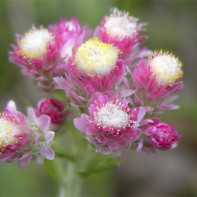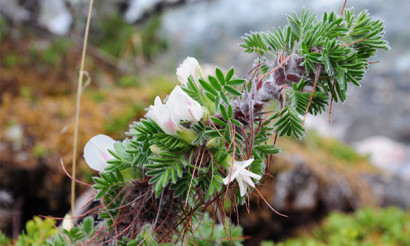Cat's paw: medicinal properties and contraindications
Antennaria is not accidentally called in the people the cat's paw. First, the flower bud of the plant really does resemble the paw of a pet. The second explanation of this name is associated with the legend, according to which a stray cat saved a sick child by bringing an unknown herb into the house. The owner prepared a decoction from this plant and gave it to the child. Soon the baby recovered, and the wonderful herb has since become known as "cat's paw."
- Chemical composition
- How it looks and where it grows
- Areas of growth
- Types of
- Gathering and storage
- Cat's paw medicinal properties
- Cat's paw in traditional medicine
- Means for eye diseases
- Blood-stopping infusion
- Liver decoction
- Balm for douches
- Tincture for mastopathy
- Gargle
- Soothing Potion
- Remedy for eye diseases
- Healing Compounds
- Tincture
- Tincture
- Decoction
- Contraindications for use
There is much truth in this mythical story. In Russia, the healing plant was widely used as an effective styptic. With the help of the herb eliminated intestinal problems and treated coughs. Folk healers claimed that the mysterious herb could cure a person of hundreds of diseases. In the official directory of medicinal plants, unfortunately, antennaria is not listed. But since ancient times, unique recipes involving this plant have survived and are widely used today in home therapy. Cat's paws is a very useful herb. It deserves to tell more about its unique composition and medicinal properties.
Chemical composition
Cat's foot in its composition contains a full complex of nutrients and chemical compounds that provide a number of therapeutic properties. The main part of the components is concentrated in the ground part of the plant. The following active elements are present in the herb:
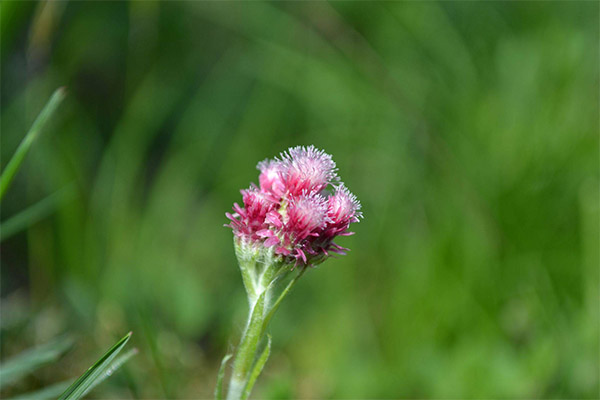
- Tannins cleanse the body from toxins and free radicals, exhibit anti-inflammatory properties, stimulate digestion.
- Ascorbic acid (or the well-known vitamin C) reduces the concentration of uric acid, strengthens the immune system, participates in the synthesis of important hormones, regulates cellular respiration.
- Resins have antiseptic properties, promote wound healing, inhibit the development of putrefactive processes in the intestines.
- Vitamin K is a whole group of substances regulating blood composition. In particular, this substance contributes to the production of prothrombin, an enzyme that ensures blood clotting.
- Saponins localize inflammation foci and normalize the water-salt balance. This group of substances also stimulates the production of some important hormones.
- Phytosterols have a detrimental effect on viruses and bacteria, neutralize toxins, and participate in the synthesis of hormones.
- Essential oils have a positive effect on the cardiovascular system, improve gastrointestinal function, show anti-inflammatory activity.
- Alkaloids normalize blood pressure, relieve pain, have a certain effect on the CNS (large doses of the drug depress it, and small ones - cause a strong excitement).
In addition to these components, the plant contains many other useful substances for human health. And although antennaria is not included in the register of basic medicines, professional physicians do not deny its therapeutic abilities. Herbalists always prepare the raw material for the future in order to prepare later medicinal compositions for home therapy.
What does it look like and where does it grow?
Cat's paw is not distinguished by its attractive appearance and bright beautiful inflorescences. This dicotyledonous plant, belonging to the family Asteraceae (Complexiflorous) and the genus Cat's Foot, looks modest. The main characteristics of the perennial:
- Growth. An adult plant reaches a height of no more than 30 cm. The dwarfism of Antennaria is explained by its resistance to high temperatures, which, however, is characteristic of all heat-loving plants.
- The stems are protected by a tufted cover. Therefore the grass is not afraid of drought and easily tolerates 30-degree frosts.
- The bright green leaves of the crop are flawlessly smooth on the outside, while their lower part is rough, with a silvery tint. The bulk of the foliage is gathered near the ground in a rosette.
- The thin root of the cat's paw divides into many branches, due to which the plant is firmly fixed in the ground.
- The small flowers form a basket-like inflorescence reminiscent of a cat's paw. They are as soft and velvety as pets. The male inflorescences have a white hue, but they have a coarser outline than the delicate pink female baskets.
- The fruit is oblong. It resembles a cylinder and is complemented by a tufted tuft.
This is interesting: Cat's paw blooms only when the stem reaches 25 cm in height.
Areas of occurrence
Antennaria is among the most common species of wild vegetation on the planet. This representative of the flora, like a universal soldier, is not afraid of either heat or cold. Having a natural protection in the form of a felt cover, the grass is able to accumulate and preserve water resources. Favorite places for settlement are sunny forest glades, fields, meadows, uplands. Abundance of light is the main condition for the comfortable life of the plant. Therefore, when you want to find a healing herb, you should always focus on open places.
You can meet cat's paw in almost all Russian regions. The herb feels great in Japan and North America. It occupies large territories in Kazakhstan and the Kuril Islands. Even in the foothills of the Caucasus and the northern tundra it is not difficult to find this unattractive but very useful plant. The grass adapts well to the harshest conditions of existence. Some species of antennaria complement the sparse landscape of Arctic regions.
Good to know: If you plant cat's paw in fertile soil, the grass will quickly stretch upward, losing its natural compactness.
Types
People have endowed the cat's paw with more than a dozen brightly colored names. Therefore, there is often difficulty in determining species affiliation. For example, antennaria is often called "chest herb" for its ability to cure coughs, it is known as "white immortelle". But with the sand immortelle, which is easily recognized by its bright yellow inflorescences, the cat's paw has nothing in common. And people gave this name to the healing herb for the fact that in dried form it does not lose the freshness of the just picked plant. Also common are nicknames such as strawberry, gorilla, Kamchuk.
Botanists find it difficult to name the exact number of species of cat's paw. Some scientists claim that there are more than 100 of them, but the guidebook has a description of only 50 varieties of grass. Only 10 species are distributed in the Russian territory, and almost all of them live in the Arctic zone. The plant is protected by law, so there are species of antennaria included in the Red Book.
Frequently occurring species include:
- Cat's paw bicentennial is the most common variety that herbalists harvest for medicinal purposes. Flowering time is May-June.
- The Carpathian species differs from the dicot species in that it has a complete lack of foliage at the flower stalk. The habitat of the cat's paw of this species is the Carpathians.
- The alpine variety grows in the north of Europe. The flowering stem reaches a height of up to 25 cm and small grayish-green leaves up to 5 cm. The flowering period is from July to August.
- The common cat's foot is a dwarf species, which does not exceed 10 cm in height. The flowering period coincides with midsummer. The coloration of the inflorescences varies from snow-white to deep red tones.
- The plantain species is found mainly in regions of North America. This variety is distinguished by its tall (up to 40 cm) flower stalks and large plantain-like leaves.
- The large-leafed (sunny) cat's paw is also found mainly in North America. A very heat-loving, short plant with large leaves and white inflorescences.
- The tufted variety is a member of the Arctic flora. A small plant with very narrow, only 1 cm wide, leaves.
This is interesting: In ancient times, the cat's paw was often called "nechuyevik" in honor of the mythical plant nechuy-veter. According to ancient folk tales, this herb helped find treasures for blind people.
Harvesting and storage
When used properly, cat's paw can help cure a huge number of ailments. Simple compositions based on it will improve the condition even in chronic pathologies, as well as help prevent the development of serious disorders. But for medicinal purposes, only the above-ground parts of the herb are used, i.e. leaves, inflorescences and fruits. Therefore, harvesting valuable material can be engaged from the flowering season, that is, from the beginning of May to the end of August, when the fruits ripen. It is worth noting at once that in the pharmacy you can not buy ready-made raw material of cat's paw. Usually such a medicinal herb is sold in pharmacies of folk herbalists, as well as in stalls at monasteries.
The rules for collecting plant material are not complicated:
- Stems, leaves, flowers should be collected at the height of flowering. It is also possible to remove the inflorescences during the budding period. At these stages, the herb is saturated with the most useful components.
- Collected raw materials should be cleaned of foreign debris, sorted and placed for drying under a shelter. It can be stored and used for up to three years.
- It is also allowed to collect the inflorescences even before the opening of the baskets, but then their storage period is reduced to one year.
For long-term storage, well-dried material should be distributed in paper bags or cardboard boxes.
For storage, medicinal raw materials should be placed in a cool, but dry room.
Warning: Cat's paw herb should not be subjected to hot drying methods.
Therapeutic properties of cat's paw

People unfamiliar with the cat's paw are usually surprised when they learn about its incredible medicinal powers. It is no coincidence that many healers say that in a small unattractive plant is concentrated a whole pharmacy store. And such a comparison cannot be considered an exaggeration, as antennaria successfully copes with a variety of diseases and ailments. It is especially highly valued in gynecological practice, as it promptly stops uterine bleeding. In addition to its hemostatic properties, the perennial has the following therapeutic effects:
- wound-healing;
- antispasmodic;
- antiseptic;
- analgesic;
- sedative;
- anti-inflammatory;
- diuretic;
- expectorant;
- choleretic;
- antitumor;
- vasodilator.
All these therapeutic effects are fully manifested during the reception of simple dosage forms prepared from this medicinal plant.
At what pathologies the herb of the cat's paw will help
Since the composition of the plant contains potentially dangerous components such as alkaloids, before using drugs prepared according to folk recipes, it is worth to consult with a doctor. Usually, professional medics willingly complement the complex treatment with herbal remedies.
Cat's paw can be considered a universal remedy, because compositions based on this wonderful herb help in the treatment of the following pathological conditions:
- hypertension;
- cholecystitis;
- hemorrhoids;
- bleeding of various nature of origin;
- skin diseases;
- tuberculosis;
- inflammatory diseases of the respiratory tract;
- hernia;
- whooping cough;
- hepatitis;
- exudative diathesis in children;
- open wounds;
- menstrual disorders;
- ulcer disease;
- glaucoma and other eye diseases;
- diseases of the female reproductive organs;
- stomatitis and gingivitis;
- diarrhea;
- venereal diseases;
- gout and many other diseases.
The plant is especially in demand in gastroenterology and gynecology, because almost any problem can be solved with the help of the healing herb. Scientists have well studied Antennaria dioica and proved by practical means that the plant has a high anticarcinogenic activity. Therefore, preparations with cat's paw can serve as an effective prevention against cancer.
Cat's paw in folk medicine
Over centuries of practice, folk medicine has accumulated a wealth of experience in treating a variety of diseases with herbs - from stomach cramps to severe cancer. Therefore, herbalists and healers know well how to properly work with the plant material, so that it does not lose its value.
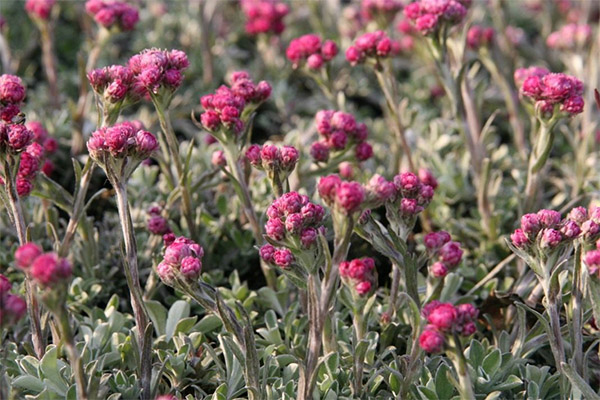
Preparing compositions from the cat's paw is not difficult. In the handbook of folk medicine there are simple and complex recipes using this useful plant. There are also universal means that can be used for different pathologies. But there is one nuance that is worth remembering. Different parts of the plant should be used to treat different diseases.
Stems and leaves. From these parts of the cutthroat plant, you can prepare medicines for ingestion for all types of bleeding. Such solutions are used for external treatment and douches, for example, in gonorrhea. And the powder from the dried herb is recommended to sprinkle on wounds and burn surfaces for better healing.
Inflorescences in dried form are suitable for the therapy of intestinal and stomach problems. Decoctions and infusions improve the function of the liver, destroy stones in the bile ducts, help with hepatitis of any type.
After getting acquainted with the features of the healing plant, you can proceed to a review of the most popular formulations.
Remedy for the treatment of eye diseases
This extremely simple method of therapy will help improve vision and cope with cataracts and glaucoma. The procedure consists of placing some flowers in a canvas baggie, and then soaking it all in boiling water. Such a compress should be applied to the sore eyes daily before going to bed.
A styptic infusion
This recipe is relevant for uterine bleeding or heavy periods. The solution is prepared at the rate of: 100 ml of boiling water - 1 tbsp of the herbaceous part of the cat's feet. After combining the two components, the solution should infuse for at least half an hour, then it should be strained. Take the medicine for severe bleeding every hour, 1 tbsp.
The remedy can be used for tampons.
Decoction from the leaves and baskets of antennaria will also help to stop bleeding of any genesis.
To do this, it is necessary:
- First mix 10 g each of dried flowers and leaves, and then pour a glass of boiling water over the plant mixture.
- The vessel with the resulting composition put on a low heat.
- Boil the mixture for a quarter of an hour.
- When the solution cools, filter it well.
- Bring the volume to the original level by adding distilled water.
Take the decoction for bleeding by 1 tbsp. The frequency of intake depends on the intensity of blood loss.
Note: The decoction prepared according to this recipe is recommended to be used for compresses in the treatment of skin rashes.
Liver decoction
This remedy can be drunk with liver problems and gallbladder dysfunction. Prepare the tool is best in a thermos. Component proportions: 2 tbsp. of dried flowers should be taken with a glass of boiling water. After combining the ingredients cover the thermos with a cork. Within half an hour, shake the infusion several times, then pour the mixture into an enamel pan and place on low heat. Boil the composition for 5-7 minutes, then remove from the stove and cool. Before use, strain the decoction. Drink before eating three times a day by 1 tbsp. The course of such treatment is 10 days, but if necessary to continue the therapy you need to make a one-week pause.
Means for douches
Professional gynecologists recommend this method of treatment for vaginitis and acute colpitis in women. For the irrigation procedure, prepare a decoction according to the standard scheme: 2 tablespoons of the herb Antennaria per glass of water. Before using, bring the volume of liquid to a liter. Procedures should be performed in the acute course of the inflammatory process twice a day. Instead of sprinkling in the vagina, tampons soaked in the solution can be inserted.
Tincture for the treatment of mastopathy
This complex collection includes the following ingredients:
- red dry wine - 0.6 l;
- St. John's wort (inflorescences) - 2 tbsp;
- nettle leaves - 1 tbsp;
- aloe juice - 180 ml;
- kite mountain (grinded into powdered roots) - 2-3 tbsp;
- cat's foot (flower baskets) - 2 tbsp;
- honey - 600 g.
Algorithm of preparation of the tincture:
- First, in a container, combine all the herbal ingredients.
- Pour the base of wine, add honey.
- Put the mixture on a water bath, with careful stirring keep it there for two hours.
- After removing from the fire, let the composition cool slightly, and then filter the tincture.
Take the cure for mastopathy can be taken 2-3 times for 30 drops.
The duration of the course of therapy depends on the dynamics of the pathological process. But as practice shows, after the first days of use, the condition of patients improves markedly.
Means for gargling the throat
This recipe can be considered universal, because it is suitable not only for the treatment of angina, but also relieves the symptoms of inflammation in stomatitis.
The method of preparation of the infusion is simple: for one part of herbal raw materials, take 5 parts of water. Bring the liquid base to a boil, and then pour the herb with it. Insist the solution for an hour. It is recommended to gargle the throat and mouth several times a day. Such an infusion is suitable for compresses for rashes and open wounds on the surface of the skin.
Soothing decoction
To prepare this remedy, you will need to take a glass of water and 10 grams of dried flowers of St. John's wort. Place the herbal raw material in a container, pour water over it and put on a low heat. The decoction should boil for no more than 5 minutes. Then let it infuse, and after half an hour the solution can be strained.
The treatment is carried out according to the following scheme:
- On the first day, drink 1/4 cup in the morning before meals.
- On the second day, take exactly the same portion already twice: in the morning and in the evening.
- The third day of treatment - 3 receipts. Single dose - 1/4 cup.
- The next two days - take already half a cup of broth three times a day.
- After the therapeutic five days to make exactly the same break, and then resume treatment.
The full course together with the pauses is 30 days.
Cooked according to this recipe decoction can be used for external treatment of wounds or to make compresses with furunculosis. The decoction also helps in the treatment of hepatitis.
A remedy for eye diseases
The method of treatment is very simple: you need to take two cotton disks, put between them a few flowers of antennaria, and then dip them into boiling water. To activate the useful components of the plant, you should keep the herb in the boiling water for a while. When the water cools, put cotton compresses on the eyelids. Duration of the procedure - 30-40 minutes. For greater effectiveness, put a sheet of parchment on top of the discs, and then wrap everything with a terry towel.
Important: Before preparing any medicinal forms, you need to make sure of the quality of plant raw materials. It is also important to observe the permissible storage time of the natural component.
Types of medicinal compositions
Despite the content of alkaloids in the composition of zalotushnik, the plant does not belong to the poisonous species. This feature allows you to prepare at home medicinal forms of different concentrations. For example, less concentrated solutions are used for internal administration, and for external treatment it is worth increasing the proportion of the herbal component. But a wide range of compositions does not exclude the main rule - in the process of preparing medications, you need to follow the instructions clearly.

Some people believe that by increasing the dose of the drug, they can achieve the maximum therapeutic effect. But this dangerous misconception can lead to serious complications. Therefore, it is not worth risking your health.
Although folk healers and herbalists offer a huge number of unique recipes with cat's paw herb, many popular remedies are prepared according to the classic scheme. Let us tell you how to properly prepare the medicinal forms that are most often used in home treatment.
Infusion
According to the classic recipe, the infusion is prepared as follows:
- 1 tbsp. of flowers pour boiling water (0.3 l).
- Leave the composition for 3-4 hours to infuse.
- Then strain the solution well.
Take 1 tbsp. at signs of gastric bleeding.
Frequency of intake - every 2 hours.
With nasal bleeding, the solution obtained in this way can be used to tampon the nasal passages. If the gums are bleeding, it should be used to rinse the mouth. The composition is suitable for stopping hemorrhoidal bleeding. Only in this case, it is necessary to make lotions with the solution on the anus area.
Tincture
Prepared according to the proposed recipe, the remedy is suitable for both external and internal use. Such a tincture relieves inflammation, stops bleeding. To achieve the maximum therapeutic effect, it is desirable to combine both methods.
The sequence of preparation:
- Raw materials in the amount of 1 tbsp pour 100 ml of vodka.
- Insist the composition in a dark and warm place for a week.
- A container with the tincture shake regularly.
- Before use, strain the solution.
For ingestion, a single dose is 30 drops. It is better to dilute this amount of tincture with water and then drink it.
For external treatment, 1 tsp of tincture should be diluted in a glass of water, and then the resulting solution should be used as directed.
Decoction
It should be noted that decoctions are the most common form of preparing healing solutions. In principle, it is a universal remedy, which is equally suitable for internal reception and external procedures.
Classic recipe for decoction of the cat's paw
This remedy is useful to take those who have problems with blood clotting. Aqueous tincture is prepared as follows:
- Take 2 tbsp of plant powder antennaria, and pour the raw material with a glass of boiling water.
- Put the composition on the fire. Boil for 10 minutes. To prevent intensive evaporation cover the pot with a lid.
- After infusion strain decoction.
Take 2 tablespoons for half an hour before a meal.
Another popular recipe among healers decoction:
- Pour boiling water 60-70 grams of powder obtained from the seeds of the cat's paw.
- Put the composition on a low heat. Bring to a boil, and then remove.
- Allow the broth to infuse for two days, then strain.
Use this product to treat wounds.
For internal use, the decoction is prepared in the same proportions, but instead of seeds, you need to use leaves and flowers. Take the remedy internally immediately after preparation. To improve the taste, you can add a little honey.
Addition: Decoctions and infusions prepared according to these recipes from the herb cat's paw will help to normalize the menstrual cycle, get rid of white, cure menorrhagia.
Contraindications for use
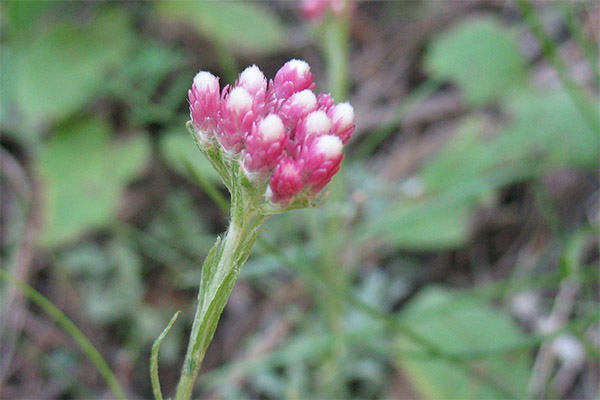
Despite a lot of positive qualities, the herb cat's paw has a number of contraindications. In particular, it is strictly forbidden to take oral remedies from this plant:
- During pregnancy and breastfeeding;
- Children under 12 years of age;
- Patients with thrombophlebitis;
- Individual intolerance.
Very carefully to use remedies for internal use of hypertension.
Cat's paw has been helping our ancestors for centuries. Healing herb and today is beneficial to sick people. For practical use, healers can offer a mass of quite effective formulations, in which the main component is the plant parts of the herb cat's paw. But in this matter it is better to rely on the opinion of experts.
«Important: All information on this site is provided solely for introductory purposes. Before applying any recommendations, consult with a specialized specialist. Neither the editors nor the authors shall be liable for any possible harm caused by materials."

